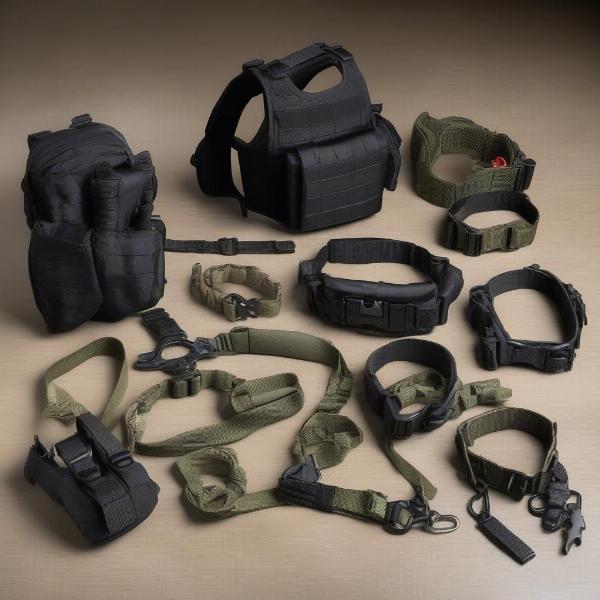Tactical dog training goes beyond basic obedience. It focuses on developing a dog’s physical and mental capabilities to perform specific tasks, often in demanding environments. This approach emphasizes clear communication, strong bonding, and consistent reinforcement, producing a highly responsive and reliable canine partner. Whether you’re interested in personal protection, search and rescue, or simply enhancing your dog’s focus and control, understanding the principles of tactical dog training can be incredibly beneficial.
Understanding the Goals of Tactical Dog Training
Tactical dog training isn’t just about teaching impressive tricks; it’s about building a strong working relationship based on trust and mutual respect. It equips dogs with the skills to handle high-pressure situations, remain focused amidst distractions, and respond precisely to commands. The core of this training involves conditioning dogs to perform complex actions reliably and safely, even under stress. This involves a significant time commitment and requires patience, consistency, and a deep understanding of canine behavior. Are you ready to embark on this rewarding journey with your furry friend?
Key Components of Tactical Dog Training
Several crucial elements contribute to effective tactical dog training. These include:
- Clear Communication: Using consistent verbal cues, hand signals, and body language is essential for effective communication. This avoids confusion and ensures the dog understands exactly what is expected.
- Positive Reinforcement: Rewarding desired behaviors with praise, treats, or toys motivates the dog and strengthens the bond between handler and dog.
- Consistency: Regular training sessions and consistent application of commands and reinforcement are key to building reliable responses.
- Progressive Training: Starting with simple commands and gradually increasing complexity helps the dog learn and retain information effectively.
- Socialization: Exposing the dog to various environments, people, and other animals builds confidence and adaptability, crucial for handling diverse situations.
 Tactical Dog Training Equipment
Tactical Dog Training Equipment
Choosing the Right Equipment for Tactical Dog Training
Investing in the right equipment is crucial for both the dog’s safety and the effectiveness of the training. A leather dog harness provides excellent control and durability, while a dog collars with handle allows for quick corrections and close-quarters handling. For larger breeds, a huge dog harness offers the necessary strength and support. Choosing equipment appropriate for the dog’s size and the specific training activities is paramount.
Is Tactical Dog Training Right for You and Your Dog?
Tactical dog training demands dedication and commitment from both the handler and the dog. It’s not a quick fix but rather a continuous journey of learning and growth. While the results can be immensely rewarding, it’s essential to assess your own commitment level and your dog’s temperament and suitability for this type of training. “Not all dogs are cut out for tactical training,” says renowned canine behaviorist, Dr. Amelia Shepherd. “It requires a certain drive, focus, and willingness to work in partnership with a human.”
Conclusion
Tactical dog training provides dogs with valuable skills that extend beyond basic obedience, fostering a strong bond between dog and handler. While demanding, the rewards of a well-trained, responsive, and reliable canine partner are immeasurable. Remember to prioritize clear communication, positive reinforcement, and consistency throughout the training process. By understanding and applying these principles, you can unlock your dog’s full potential and build a truly remarkable partnership.
FAQ
- What breeds are best suited for tactical dog training? While many breeds can excel, those with high drive, intelligence, and working backgrounds, such as German Shepherds, Belgian Malinois, and Dutch Shepherds, are often preferred.
- How long does it take to train a tactical dog? The duration varies depending on the dog’s aptitude and the complexity of the tasks, but it’s a continuous process that requires ongoing commitment.
- Is tactical dog training cruel? When done correctly, using positive reinforcement methods, tactical dog training is not cruel. It should focus on building a strong bond and empowering the dog.
- Can I do tactical dog training myself? While professional guidance is recommended, especially for advanced skills, basic principles can be applied by dedicated owners.
- What are the benefits of tactical dog training? Beyond specific tasks, it improves focus, control, responsiveness, and strengthens the dog-handler bond.
- Is tactical dog training only for working dogs? No, it can benefit any dog owner looking to enhance their dog’s training and build a stronger relationship.
- What is the difference between tactical dog training and protection dog training? While there’s overlap, protection training focuses specifically on guarding and defense, whereas tactical training encompasses a broader range of skills.
Related Articles
No related articles found.
About ILM Dog
ILM Dog is your trusted international resource for expert dog care and training advice. We cover everything from breed selection and puppy care to advanced training techniques and product recommendations. Whether you’re a seasoned dog owner or just starting your journey, ILM Dog provides the information you need to nurture a happy, healthy, and well-behaved canine companion. For personalized guidance on k9 dog collars or search and rescue dog harness, connect with our experts via email at [email protected] or call us at +44 20-3965-8624.